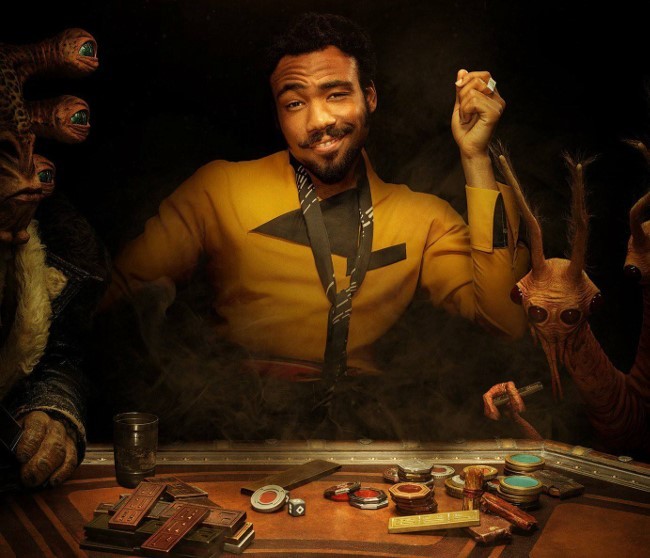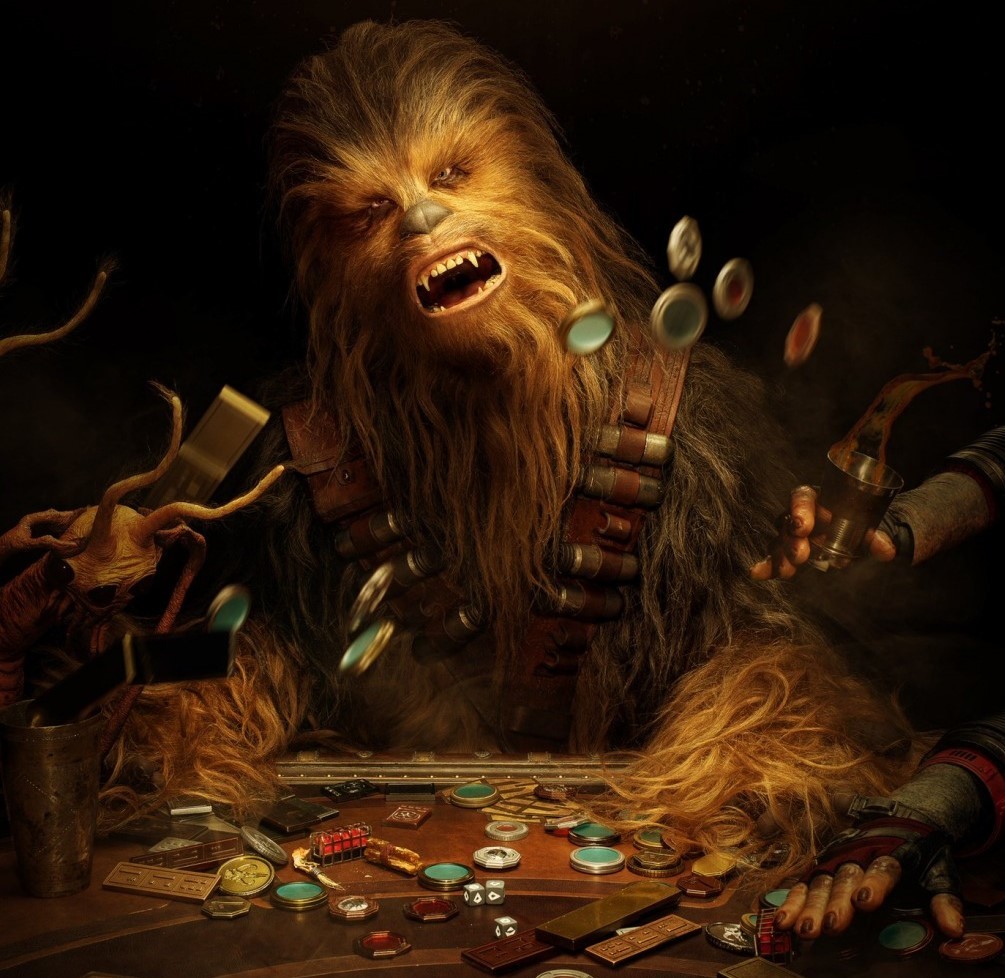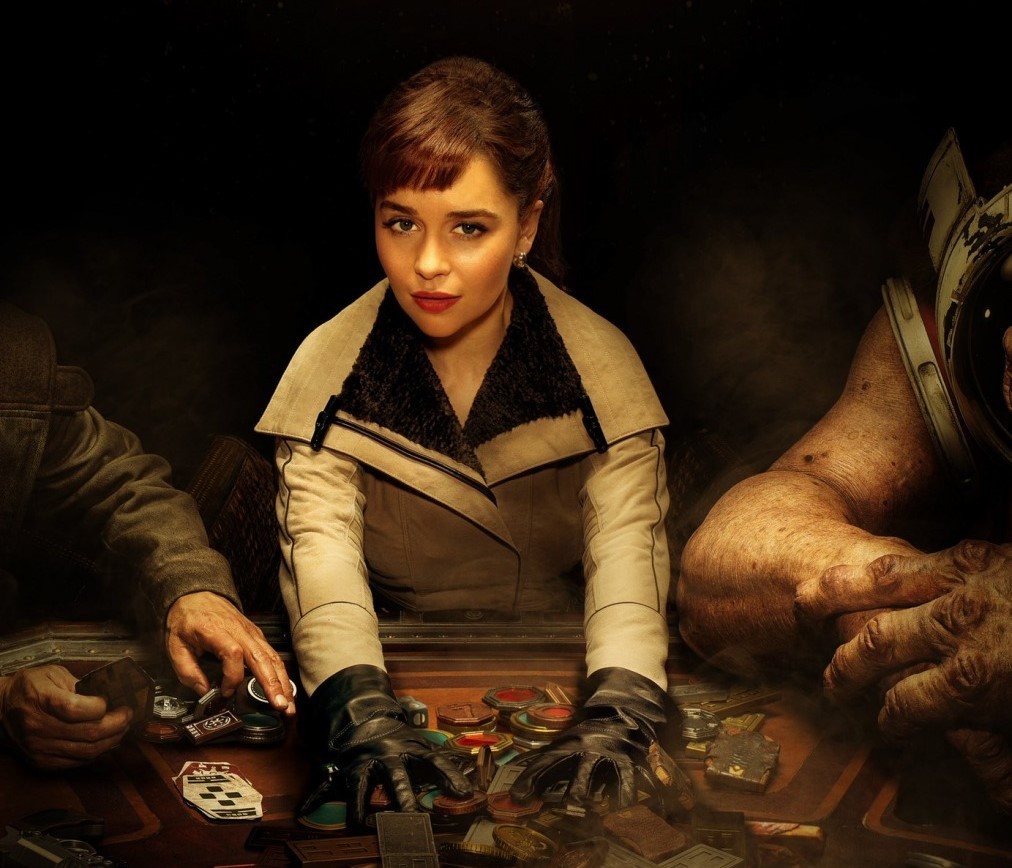You won't find sabacc games in Atlantic City or on the Vegas strip, but in places like Canto Bight and Cloud City, sabacc is the discerning gambler's game of choice. In Solo: A Star Wars Story, the sabacc table is where Han meets Lando, sparking a friendship that lasts for decades, and it's sabacc that they're playing when Han wins the Millennium Falcon, changing the fate of the galaxy forever.
Sabacc is more than just a plot device, however. It has a complete set of rules, numerous variants, and a long and storied history in the Star Wars universe. With a little bit of work, you can even play it yourself.
The Galaxy's Most Notorious Game
Sabacc actually predates The Empire Strikes Back, but just barely. While sabacc isn't named in the film itself--When talking to Lando, Han simply says that he won the Falcon "fair and square"--the second draft of Empire's screenplay mentioned that the game is called "sabacca." The Empire Strikes Back's novelization, written by Donald F. Glut, renamed it "sabacc." That's what it's been called ever since.
Next came L. Neil Smith's Lando Calrissian and the Mindharp of Sharu, one of the earliest installments in the now non-canonical Star Wars Expanded Universe. Set a few years before Han sat in the Falcon's pilot's seat, The Mindharp of Sharu details Lando's adventures in the Rafa system, where he's roped into hunting for an ancient treasure alongside a tentacled droid named Vuffi Raa. Sabacc plays a big, big role in the story.
Even by Star Wars standards, The Mindharp of Sharu is supremely weird, and later novels more or less ignored it. The book did make one lasting contribution to Star Wars lore, however. The Mindharp of Sharu begins with a sabacc match and quickly lays out the game's rules. That's been the foundation for every version of the game that followed. In fact, sabacc hasn't changed much at all since The Mindharp debuted all the way back in 1983.

Game designers Michael Stern, Douglas Kaufman, and Greg Gorden codified sabacc's rules in Crisis on Cloud City, an adventure module for West End Games' classic tabletop game, Star Wars: The Roleplaying Game. The original version of Crisis on Cloud City included a pamphlet explaining sabacc's ins and outs, a deck of 84 full-color cards, and a side quest that saw players gambling against Lando Calrissian himself by playing an actual game of sabacc. Those rules were used as the foundation for a special (and simplified) version of sabacc released at Star Wars Celebration Anaheim in 2015, the gambling scenes in Solo, the Star Wars Rebels episode "Idiot's Array" (which also features a Billy Dee Williams guest spot), various role-playing games, and many, many spin-off novels.
In-world, sabacc's been a mainstay at criminal hubs and dingy cantinas for years, although it wasn't always around. Before sabacc, people played pazaak. While similar to sabacc, pazaak uses both standard and player-made decks, and includes cards that can change the values of other players' hands. If this sounds familiar, you might've played it before: pazaak was a mini-game in BioWare's popular video game, Knights of the Old Republic.
How It Works
Sabacc itself is like a combination of blackjack and poker, with a little bit of roulette thrown in for good measure. Similar to blackjack, the goal of the game is to put together a hand that's worth 23 points (or negative 23 points), or as close as you can get. You have to be careful, however, because if you break the 23 limit in either direction, or if you end the game with zero points, you'll "bomb out." That's like busting in blackjack: when you bomb out, not only do you lose the hand, but you have to pay a predetermined penalty into the so-called "sabacc pot."
You gain and lose points by collecting cards from the sabacc deck, which is based on real-life tarot cards (in fact, in Star Wars lore, sabacc cards can also be used for fortune telling). A traditional sabacc deck consists of 76 cards, most of which fall into one of four suits: sabres, staves, flasks, and coins. Every suit is made up of 11 regular cards, which are valued at 1 through 11, plus four "ranked" cards--the Commander, the Mistress, the Master, and the Ace--that are worth 12 through 15 points, respectively.

The rest of the deck is composed of 16 face cards. There are eight kinds of those, and every deck has two of each. Those are: the Idiot (0 points), the Queen of Air and Darkness (-1), Endurance (-8), Balance (-11), Demise (-13), Moderation (-14), The Evil One (-15), and The Star (-17).
Unfortunately, a sabacc deck isn't something that you can just walk into any old store and buy. You'll have to get creative. Many people like combining two decks of tarot cards (West End Games' rules are explicitly designed to make that possible), and you can mark up some traditional playing cards by hand, too. You can also print out your own deck or scour eBay for copies of Crisis on Cloud City, although complete editions of the module are both rare and expensive.
The Rules
A sabacc hand starts with every player, including the dealer, receiving two cards, which are dealt face-down. Then, the betting round begins. Starting from the dealer's left, each player looks at their cards and choose whether to match the current bet, raise, or fold. Bets go into the "hand pot," while anyone who folds must pay a penalty into the sabacc pot.
Now, unlike other, low-tech card games, sabacc cards can change during play. This is called the "shifting" phase, during which one of your cards has a 50% chance of changing into something else. In Star Wars, this happens automatically. If you're playing in real life, you can simulate the effect by having every player roll a six-sided die. If you roll a 1, 2, or 3, the player to your left randomly chooses which card you should discard, and you'll draw a new one from the deck in its place.
You can protect your cards from the shift by using the sabacc table's "interference field." Before the shifting phase begins, you can put a single card in the field. That'll keep it from changing, but you'll need to play it face-up, showing everyone at the table what you've got. There's no limit to the number of cards you can put in the interference field, but you can only add one per turn.

From there, the drawing phase begins. Going clockwise around the table, every player can draw one card from the deck and discard one card from their hand. You don't have to do either, of course. As long as there are at least two cards in your hand at all times, you're good. There's no limit to the number of cards that you can hold.
After four rounds of betting and shifting, any player who wants to call the hand can, before the drawing phase begins. When the hand is called, everyone shows their cards. Whoever has the hand closest to 23 or -23 without bombing out wins the hand pot. If no one calls, the cycle repeats until someone does.
Sabacc has two special hands that beat all the others. A "pure sabacc" consists of a hand that totals exactly 23 or -23. An "Idiot's Array," which is even better, is made up of the Idiot, any 2-point card, and any 3-point card. If you manage to win a hand with either of those hands, you'll pick up the sabacc pot in addition to the hand pot. Otherwise, the sabacc pot just keeps growing.
What About The Dice?
If you've been paying attention to the recent Star Wars films, you might remember that Han Solo kept a pair of gold dice hanging in the Millennium Falcon. Star Wars: The Force Awakens: The Visual Dictionary explained that these are the dice Han used to win the ship from Lando, and he kept them around as a lucky charm. And yet, sabacc is a card game. Dice aren't usually involved. What gives?
Well, like poker, sabacc comes in many different variants. In Empress Teta Preferred, for example, players swap cards before revealing their final hands. Centran sabacc uses a slightly different deck. Regional and house rules often dictate how to break ties, as well as offering new and improved ways to separate opponents from their hard-earned cash.
According to The Visual Dictionary, Han and Lando faced off in Corellian Spike, which uses dice to make the game even more unpredictable. Presumably we'll see that in Solo.
That's it. Other than the cards themselves, you've now got everything you know to gamble like a smuggler, bounty hunter, or any other kind of intergalactic ne'er-do-well. Now go win yourself a starship.



